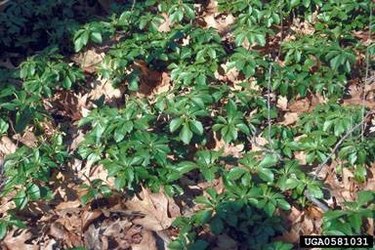
Pachysandra (Pachysandra terminalis, USDA plant hardiness zones 5 to 9) is a perennial evergreen that thrives in deep to light shade, but it is known to be invasive. If you are interested in removing pachysandra from your property, it is possible to do so without a tremendous amount of effort. You can even replace it with a noninvasive ground cover for shade afterward.
Tips for Removing Pachysandra
Video of the Day
While pachysandra is a good ground cover for areas that are shaded or have poor soil, it is fast-growing and can easily take over spaces you'd prefer that it avoid. Also known as Japanese pachysandra, this hardy perennial spreads out, forming dense ground cover mats that can take over landscapes and gardens. There are mechanical and chemical methods for removing pachysandra depending on how much of it you need to deal with.
Video of the Day
The first method involves digging up the plants by hand. While this may work in small areas, it can take forever in larger ones. It is essential to get all the rhizomes (horizontal underground stems and roots) out of the ground. Otherwise, the pachysandra will return. If you want to try another natural solution, some experts claim that covering the pachysandra with black plastic will help, but this takes around three months and can be difficult depending on how much pachysandra there is.
Herbicides are the better choice for larger areas. Use a systemic, broad-spectrum herbicide, such as glyphosate in a 2-percent solution. When choosing one, read the label for the ingredients and usage instructions. These also contain surfactants, which allow the glyphosate to adhere to the plants. Just be sure not to apply it on a windy or rainy day. Otherwise, the herbicide can blow off, wash off and flow into bodies of water or onto desirable plants and grasses.
Noninvasive Ground Cover for Shade
Now that the pachysandra is gone, you may want a new noninvasive ground cover for shaded areas on your property. One popular choice is creeping phlox (Phlox stolonifera, USDA hardiness zones 3 to 9). It has the main attraction of large, violet-blue flowers, and it also grows in full sun.
Fetterbush (Lyonia lucida, USDA hardiness zones 7 to 9) is another good choice. It is an evergreen ground cover that features dark green oval leaves. Certain varieties have ivory flowers, white flowers or reddish leaves in the spring. Canby's mountain lover (Paxistima canbyi, USDA hardiness zones 3 to 7) is a rare ground cover that spreads out into low and thick thatches with deep green, petite leaves. These sometimes turn silver-flecked or bronze in colder temperatures.
Plants That Like Shade
There are also many beautiful flowering plants that prefer the shade to the sun. Some good options include primrose (Primula vulgaris, USDA hardiness zones 4 to 8). There are over 400 species with a color for every taste. The common foxglove (Digitalis purpurea, USDA hardiness zones 4 to 8) is another beauty, with long and tall white, purple or pink blooms.
The shade-loving astilbe (Astilbe 'Federsee,' USDA hardiness zones 4 to 9) is a colorful perennial with pretty foliage that can be light to dark green, blue-green, burgundy or bronze. The flowers come in different colors too. Finally, heuchera or coral bells (Heuchera 'Miracle,' USDA hardiness zones 4 to 8) have stunning foliage that ranges from silver to chartreuse to purple-black. Some varieties also have lovely flowers.